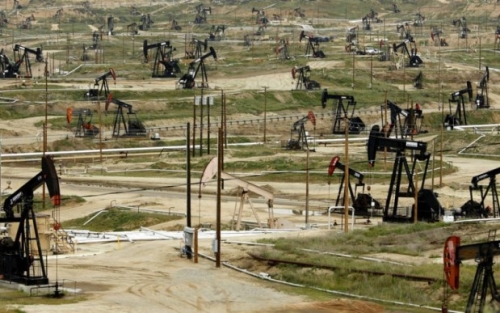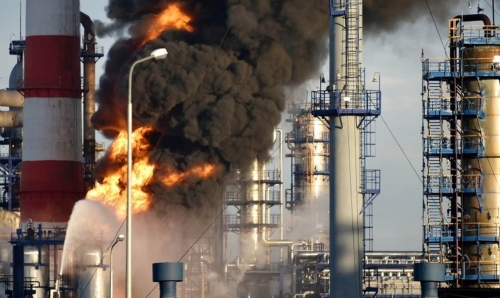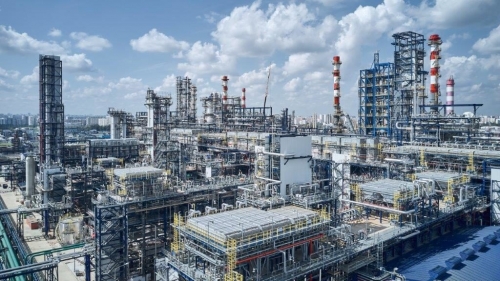Oil benchmarks declined for most of the week, with fears of further OPEC+ output cut rollbacks compounded by a contraction in the US economy. US gas prices bounced back this week after last week's collapse of nearly 10%, supported by record-high LNG export operations and end-month trading acceleration.
BKR Rig Count | The total active drilling rigs in the United States decreased by 3 last week, to 584. Oil rigs decreased by 4 to 479, and gas rigs increased by 2 to 101. Rig count in the Permian Basin decreased by 2 at 287 | May 2 | BKR NAM Rig Count
US Crude Inventories, excluding those in the Strategic Petroleum Reserve (SPR), decreased by 2.7 MMbbl to 440.4 MMbbl (about 6% below the 5y average for this time of year). On the products side, gasoline decreased by 4 MMbbl (4% below the 5y average). Distillate fuels increased by 0.9 MMbbl (13% below the 5y average). Total commercial petroleum inventories increased by 4.2 MMbbl | Apr 25 | EIA Weekly Report
OPEC+ group has agreed to increase output, which may deepen the rout in crude futures and stoke fears of a price war within the cartel. The move is seen as a strategy shift by Saudi Arabia to drive down prices and punish members who have cheated on their quotas, and may also be an attempt to ingratiate with US President Donald Trump's push for lower oil prices. Like last month, the group agreed to unleash another 411,000 b/d in June | May 3 | Bloomberg
Output from OPEC shrank by 200,000 b/d in April to 27.24 million a day. Venezuela accounted for about half of the decline as international producers such as Chevron wind down operations while President Trump’s administration tightens sanctions. It was less clear why other OPEC members such as Saudi Arabia and the UAE didn’t take advantage of the group’s agreement to finally bolster supplies. The UAE curtailed output by 80,000 b/d to an average of 3.25 million a day whereas Riyadh added just 20,000 b/d, pumping 8.97 million, only part of the agreed amount | May 1 | Bloomberg
President Donald Trump said he would impose secondary sanctions on nations or companies buying Iranian oil, ratcheting up pressure on Tehran as nuclear talks with the US hit a snag. Iran shipped about 1.7 million b/d of crude and condensates during April. China’s private refineries buy the vast majority of those exports. The US has already sanctioned two of these refineries in the past two months. Tightening those measures or targeting other Chinese entities could further inflame tensions with Beijing. It could also mean sanctions for the United Arab Emirates, a key US partner in the Middle East that also purchases Iranian petroleum products. US crude futures gained after Trump made his announcement, rising as much as 2.2% to $59.50 a barrel | May 1 | Bloomberg
China has re-exported more than 280,000 tons of liquefied natural gas so far in April, the highest volume ever in a single month. That is equivalent to 7.7% of total imports for the month. The high volume of re-exports is likely spurred by weak domestic demand, as a mild winter and robust inventories mean that China is not in any dire need for the super-chilled fuel. The nation may also benefit from higher prices abroad | Apr 28 | Bloomberg
US economic data showed that the country's GDP contracted by 0.3%in the first quarter, marking the first negative growth since early 2022, which stoked fears of a potential recession. The trade deficit widened to a record high, reflecting preemptive import increases ahead of impending tariffs, adding to economic concerns and a pessimistic sign for what is to come in this quarter and the next. Furthermore, consumer confidence sank 7.9 points to its lowest level since 2011 | Apr 30 | CBS, S&P
Looking ahead
Bloomberg has released its ‘New Energy Outlook 2025’ providing a view of how the transition might progress in a world where investment decisions are driven primarily by the need to meet rising energy demand with a cost-competitive mix of technologies – not by climate concerns. “Through this ‘Economic Transition Scenario’, we explore how far and how fast the low-carbon transition can proceed based purely on competitive economics and existing short-term policy settings.” Emissions in Bloomberg’s ETS fall 22% by 2050 (back to 2005 levels), leading to a 2.6C warming trajectory. Demand for electric power rises 75% by 2050 as economic development, electric vehicles, cooling needs and power demand for data centers push up electricity use. Demand for “useful energy” increases 32% by 2050 as populations and economies grow, but primary energy rises just 9%, as efficiency gains from electrification and renewables limit the growth of upstream energy production. In total, data centers represent 4.5% of final power demand in 2035. That almost doubles to 8.7% in 2050. In all, this is still less than the demand from EVs (11.2% in 2050), but more than air-conditioning and heat-pump load, which reaches 7.1% in 2050. Renewables generation increases 84% in the five years to 2030 and then doubles again by 2050. So, by mid-century, renewable sources serve 67% of the world’s (much-expanded) appetite for electric power, up from 33% in 2024. Overall oil demand peaks in 2032 at 104 million b/d, with road fuel peaking a few years earlier. Demand ultimately drops to 88 million b/d by 2050. Outside of road transport, oil consumption remains resilient in the ETS, with a doubling of demand for aviation and strong growth in petrochemicals through 2050. Gas now plays a larger role in our Economic Transition Scenario, due to lower long-term fuel-price expectations and higher electricity demand from data centers. Global natural gas demand increases 25% from 2024 to 2050, reaching 5,449 billion cubic meters. Much of this growth occurs after 2035, as the years up to 2034 are characterized by renewables displacing the use of gas in the power sector. But after 2035, power-sector gas consumption kicks in again, led mainly by the US, where favorable economics support investment in gas-fired generation. Not all clean energy technologies are ready to stand on their own two feet. Unlike renewables and EVs, hydrogen, carbon capture and storage, clean fuels and low-carbon industrial processes all struggle to make an impact in the Economic Transition Scenario, which assumes that policy makers offer no new financial support for low-carbon technologies | Apr 15 | Bloomberg
How trade tensions reshape China’s economic growth and oil demand dynamics. Escalating trade tensions will weigh on China’s economic growth from the second quarter onward (3.9% for the remainder of the year), despite a strong start to 2025 driven by fiscal stimulus and front-loaded shipments. S&P projects that China’s oil demand will increase by 80,000 b/d in 2025 and by 290,000 b/d in 2026, year over year. The YoY growth for 2025 has been revised down by 260,000 b/d. The most significant reductions in demand were observed in the diesel, jet fuel, fuel oil and NGLs sectors. Tariffs are expected to impact LPG imports directly, but with minimal effect on crude oil imports and major refined product exports. S&P revised down the annual real GDP growth forecasts for China to 3.8% and 3.7%, from the previous 4.2% and 4.1% for 2025 and 2026, respectively. This adjustment reflects escalating trade confrontations and persistent weaknesses in the private sector. Despite the introduction of an 11.9 trillion yuan ($1.6 billion) fiscal stimulus package in March and anticipated additional measures, the outlook remains challenging. The impact of tariffs on crude oil imports and major transportation product exports is expected to be minimal, as US imports constitute only a small fraction of the total trade in these commodities. In 2024, crude oil imports from the US accounted for merely 1.7% of China’s overall crude imports. During the trade tensions of Trump’s first term, the 5% tariff on crude oil quickly drove China’s imports to zero between December 2019 and April 2020. With a 10% tariff taking effect on Feb. 10 and now an additional 125% on US imports imposed by China, we anticipate that China’s crude imports from the US will stop entirely. The impact of the China-US tariff dispute on China’s gasoline demand is mixed. S&P expects gasoline demand to decline by 46,000 b/d, year over year, in 2025, primarily due to persistently high penetration of new energy vehicles (NEVs). Supported by the government’s stimulus policies on the demand side in 2025, the substitution of gasoline demand by NEVs is expected to continue to rise. The main impact of high tariffs on gasoline demand can be divided into two different aspects. On the one hand, amid economic headwinds, people may choose to reduce travel to cut expenses, which hurts gasoline demand. On the other hand, reducing large item expenditures, such as delaying car purchases, may slow down the substitution rate of NEVs for conventional fuel vehicles. Additionally, the overall efficiency improvement of fuel vehicles may decelerate, which could support gasoline demand | Apr 30 | S&P

%20(1).png)



